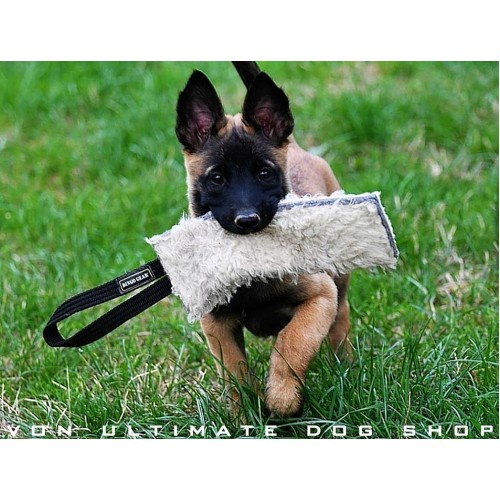The use of a bite tug in dog training is a matter of personal preference and training methodology. A bite tug, also known as a tug toy, can be a valuable tool in certain types of dog training, particularly for working dogs or those involved in activities such as Schutzhund or protection training.
Bite tugs are typically made of durable materials and are designed to withstand the dog's biting and tugging. They can be used as a reward during training sessions, promoting engagement, focus, and reinforcing positive behavior. Tug toys can also help satisfy a dog's natural prey drive and provide an outlet for their energy.
However, it's important to note that the use of a dog bite tug should be done in a controlled and structured manner. It should be part of a comprehensive training program that focuses on building a strong foundation of obedience, positive reinforcement, and clear communication between the handler and the dog.
Tugging can be a beneficial activity for many dogs when done properly and in a controlled manner. Here are some potential benefits of tugging:
- Bonding and Engagement: Tug-of-war games can strengthen the bond between a dog and its owner. It provides an interactive and engaging activity that dogs often enjoy, promoting a positive relationship between the dog and the handler.
- Exercise and Energy Outlet: Tugging can be an energetic and physically stimulating activity for dogs. It helps them burn off excess energy, which can be particularly beneficial for high-energy breeds.
- Mental Stimulation: Tug games require dogs to use their problem-solving skills and strategic thinking. It engages their minds and provides mental stimulation, which can be as important as physical exercise.
- Prey Drive Satisfaction: Many dogs have a natural prey drive, and tugging can simulate a prey-like interaction. It allows dogs to channel their natural instincts in a controlled manner, which can help prevent the development of destructive behaviors.
When engaging in tugging with your dog, it's important to follow these guidelines:
- Use an appropriate tug toy: Choose a tug toy that is safe, durable, and specifically designed for interactive play with dogs.
- Establish rules and boundaries: Teach your dog appropriate tugging behavior, such as releasing the toy on command and not becoming overly aggressive or possessive during the game.
- Supervise the activity: Always supervise tugging sessions to ensure safety and prevent any potential accidents or injuries.
- Maintain control: You should be able to control the game at all times. If your dog becomes overly excited or displays inappropriate behavior, you should be able to stop the game and regain control.
- End on a positive note: Finish the game with a command, such as "drop it" or "leave it," and reward your dog for following the command.
Remember, not all dogs enjoy tugging, and some individuals may not be suitable for this type of play. It's essential to consider your dog's temperament, preferences, and any potential behavior issues when incorporating tugging into your interactions and training sessions.
It's recommended to consult with a professional dog trainer or behaviorist who can guide you on the appropriate use of bite tugs in training and ensure that it aligns with your dog's temperament and training goals. They can provide personalized advice and help you develop a training plan that suits your specific dog and situation.


No comments yet